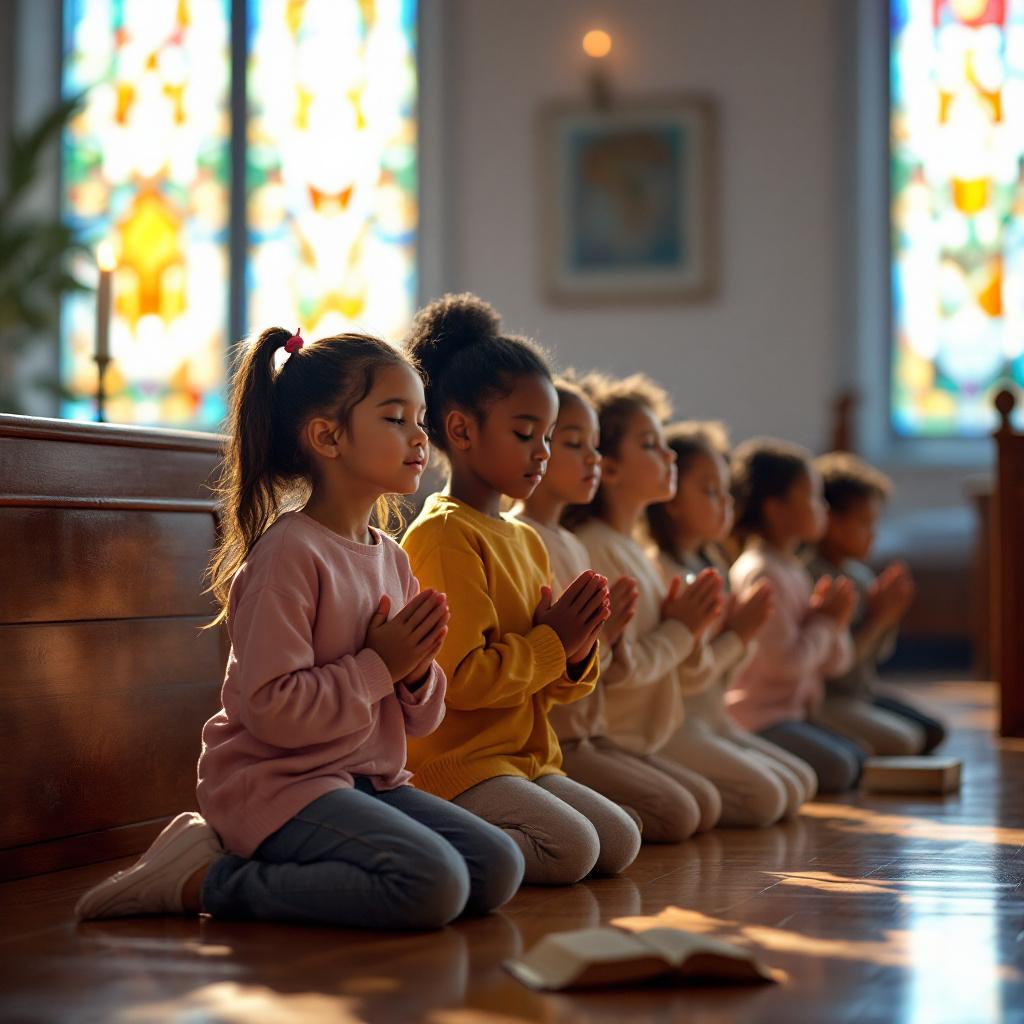
Kids learn a lot by watching adults, and prayer is no different. Teaching Sunday school kids how to pray doesn't have to feel overwhelming or complicated. Prayer gives children a way to get to know God, find comfort, and talk about what matters to them.
Making prayer simple and meaningful helps kids see it's for everyone, anytime. In this post, you'll find easy ideas that work in real Sunday school rooms, along with tips for building kids' confidence as they learn to talk with God on their own.
Understanding What Prayer Means for Kids
When you teach kids about prayer, you’re really giving them a way to talk with God as simply as talking to a friend. Prayer isn’t about fancy words or long speeches. It’s how kids express what’s on their hearts—things like saying thank you, asking for help, saying sorry, or praising God just because. Helping children see prayer as something real and personal can shape their faith in ways that last a lifetime.
Why Prayer Matters in a Child’s Life

Photo by cottonbro studio
Kids face big feelings every day—worries, hopes, excitement, and even guilt. Prayer gives them a safe place to bring those feelings. It’s their conversation with God where nothing is too small or too silly to share.
Practical reasons for kids to pray include:
- Building a sense of trust: When kids pray, they learn that they can count on God to listen, even when others might not understand.
- Feeling supported: A habit of prayer reminds kids they’re not alone. God cares, always.
- Learning gratitude: Pausing to thank God helps children notice good things, big and small, in their lives.
- Processing emotions: Saying sorry, asking for help, or sharing worries teaches kids it’s okay to be honest about struggles.
Prayer builds a foundation for faith. As explained in The Power of Prayer in the Life of a Child, praying helps kids build healthy habits for life and connects their faith with their daily experiences. It can even strengthen their relationships with family and friends as they learn to pray together.
Making Prayer Feel Natural
Some kids feel shy about praying out loud or worry about using the “right” words. The good news is that prayer isn’t a test. It’s simply speaking from the heart. You can help prayer feel easy for kids by keeping things simple and routine.
To make prayer feel natural:
- Use simple words: Encourage kids to talk to God as they would a close friend. There’s no need for big or formal phrases.
- Offer prompts: Short prompts like “God, thank you for…” or “Please help me with…” get children started and show there’s no right or wrong way to pray.
- Model prayer yourself: Praying together helps kids see what prayer looks like and gives them confidence to try.
Making prayer part of daily routines, like before meals or bedtime, helps kids feel less nervous. Try creative approaches, like drawing a picture for God, singing a short song, or using movement—whatever feels comfortable. Teaching Children to Pray: 4 Simple Tips for Families suggests that involving prayer in everyday moments shows children that God cares about every part of life.
Over time, the more kids see prayer in action, the more natural it feels. Prayer becomes something comfortable, not scary—just another way to connect with God each day.
Practical Tools and Models Kids Can Use to Pray
Kids often need something concrete to help them learn new habits, and prayer is no exception. When prayer is presented with hands-on activities or simple models, children gain confidence and remember how to talk with God in their own words. Here are a few creative and proven ways you can help Sunday school students grasp prayer in a way that sticks.
Teaching the Five-Finger Prayer
The Five-Finger Prayer makes prayer easy to remember using something every child has—their own hand. Each finger acts as a guide for a different way to pray, and you can invite kids to hold up their hand, counting the steps as they go.
- Thumb (Praise): The thumb is closest to the heart. Start by saying something good about God—like “God, You are loving and kind.”
- Pointer (Confession): Like a finger pointing out what’s right, this is about saying sorry for things we’ve done wrong.
- Tallest Finger (Listening): The tallest stands out. Remind kids to pause and be quiet, letting God talk to their hearts.
- Ring Finger (Praying for Others): This is the weakest finger, so we pray for people who need God’s help—family, friends, and anyone who is struggling.
- Pinky (Personal Requests): The smallest finger, saved for asking God for things we need or want.
Kids can spread out their fingers and move through the “prayer steps.” This visual and tactile guide helps prayer feel simple, not scary.

Photo by Binti Malu
Using the C.H.A.T. Prayer Model
The C.H.A.T. model keeps prayer short and practical. Each letter stands for a type of prayer, and you can teach kids to “chat” with God just like a friend:
- C – Confess: Saying sorry to God for mistakes or wrong choices, like “God, I’m sorry for being mean to my brother.”
- H – Honor: Giving God praise or saying something true about Him, for example, “God, You are strong and good.”
- A – Ask: Making requests for others or yourself: “Please help my friend feel better” or “Help me do well on my test.”
- T – Thank: Thanking God for specific things. Kids can say, “Thank You for my family” or “Thank You for pizza!”
Let kids try praying one short sentence for each letter. You can even make a classroom poster or small cards for them to take home. For printable tools and more ideas, check out these free printable prayer tools for families.
Exploring Prayer Stations and Activities
Prayer doesn’t have to be just about closing eyes and folding hands. Kids learn with their whole bodies, so bringing in movement and creativity helps make prayer memorable. Set up fun “prayer stations” around the room:
- Praise Wall: Let kids write or draw things they love about God on sticky notes and post them on a big sheet of paper.
- Forgiveness Basket: Kids can write or draw things they feel sorry about on slips of paper, drop them in a basket, and remember that God forgives.
- Map Prayers: Place a map or globe in the classroom. Invite kids to pick a country or city, and pray for the people living there.
- Prayer Beads or Bracelets: Kids can string beads, assigning a color for each kind of prayer (thanks, help, sorry, praise), then hold a bead and pray.
These activities get kids moving and help them see and feel their prayers. Classroom ideas like this are covered in guides such as 11 Creative Ideas for Teaching Kids How to Pray and Teaching Kids About Prayer. Activities stick in kids’ memories, making prayer natural from a young age.
Praying Through Scripture: Learning from Bible Examples
Kids connect best with prayer when they see that real people in the Bible talked to God, too—sometimes with big feelings or simple words, just like us. Teaching children to “pray through Scripture” helps make their prayers stronger and shows them that God’s Word is full of examples they can follow. Whether it’s a story about someone brave like Daniel, someone heartfelt like Hannah, or the way Jesus prayed, these stories and easy Scripture prayers give kids confidence that God really hears them.
Stories of Prayer in the Bible: Relatable Examples for Kids

The Bible is full of people—young and old—who stopped to pray when they felt happy, sad, scared, or needed help. Here are a few kid-friendly stories where prayer takes center stage:
- Daniel in the Lions’ Den: Daniel chose to pray and talk to God three times each day, even when it was against the rules. He thanked God and asked for help, showing bravery and trust. When he was thrown in with the lions, Daniel’s prayers gave him comfort and courage. For more about Daniel’s story and others like it, visit Pray without Ceasing: Bible Stories for Kids about Prayer.
- Hannah’s Prayer: Hannah wanted a child more than anything. She prayed honestly in the temple, telling God about her sadness and hopes. Her prayer wasn’t fancy, just real. God heard her and answered in a special way.
- Jesus Teaches Us to Pray: Jesus prayed all the time—before making choices, when he was alone, and when he was with friends. He even taught his friends “The Lord’s Prayer” to show them simple words they could use any time. Kids can read stories about Jesus praying and teaching others to pray in places like Matthew 6:9-13 and Parables about Prayer.
- Short Kid-Friendly Verses About Prayer: God hears prayers from anyone, at any time. Here are a few verses that encourage kids:
- “Pray without ceasing.” – 1 Thessalonians 5:17
- “The Lord is near to all who call on him.” – Psalm 145:18
You can talk about these stories with your class, or try acting them out. Help kids think about times when they have felt like Daniel, Hannah, or even Jesus—happy, scared, thankful, or in need of help. This makes Bible prayers relatable, not distant.
Simple Ways to Use Scripture in Prayer
Praying Scripture is like turning God’s words into your own prayer. It’s easy for kids to start, even if they don’t know what to say. Here are some fun and simple ways to guide children in turning short verses or Psalms into their own prayers:
- Pick a Short Verse or Psalm: Start with something simple. Psalms are great because they already sound like prayers or songs.
- Example: Psalm 56:3 – “When I am afraid, I put my trust in you.” Kids can turn this into: “God, when I feel scared, help me trust you.”
- Repeat and Personalize: Encourage kids to read a verse out loud, then put it in their own words.
- Example: Philippians 4:13 – “I can do all things through Christ who strengthens me.” A child might pray: “Jesus, help me be strong when things are hard.”
- Use Scripture as a Template: Read a line, then fill in the blank with something from their life.
- Psalm 136:1 – “Give thanks to the Lord, for he is good.” A child can pray: “Thank you, God, for being good. I am thankful for _____ today.”
Here’s a simple list to make Scripture prayers easy in Sunday school:
- Read a Bible verse together.
- Ask the class, “How could we say this as a prayer?”
- Let kids each try turning it into their own simple prayer.
- Pray together using everyone’s ideas.
For extra ideas, check out helpful guides like How to Turn Scripture Into Prayer or How to Turn Your Bible Reading Into a Conversation with God.
Using the Bible as a prayer book helps kids feel closer to God and shows them they are never alone—God listens, just like He listened to Daniel, Hannah, and Jesus.
Fostering a Habit of Prayer Beyond Sunday School
Building prayer habits in kids isn’t just for Sunday mornings. Kids learn what sticks when prayer shows up in their natural rhythms—at home, before soccer games, or as part of quiet moments after a tough day. The real goal is to help prayer feel as normal as brushing their teeth or sharing a snack with a friend.
Making Prayer Part of Daily Life: Give clear steps for weaving prayer into routines. Suggest prayer reminders and include real-life kid examples.

Prayer habits start small. You don’t have to build a quiet zone with candles every night. Kids are more likely to pray when prayer fits their unique schedule and family life. Here are some simple steps to weave prayer into everyday routines:
- Start with meal times: Encourage kids to thank God for the food on the table, even if it’s chicken nuggets or pizza.
- Try bedtime prayers: Before lights out, pray about what happened during the day, worries for tomorrow, or things your child is grateful for.
- Tuck prayer into transitions: Quick prayers before school, while riding in the car, or ahead of a sports game help kids remember God is with them everywhere.
- Use visual reminders: Place sticky notes on bathroom mirrors, pack prayer cards in school lunchboxes, or hang a small chalkboard in the kitchen with a weekly prayer prompt. Creative reminders can spark prayer in busy homes.
- Make it interactive: Invite kids to draw their prayers, write letters to God, or use movement by clapping three times and saying, “Thank you, God!” as they head out the door.
Many families find unique rhythms. One mom shared that her daughter (age 7) started asking for “one good thing and one hard thing” to pray about at bedtime. Another parent noticed their son whispering a prayer before spelling quizzes at school—it became his own secret boost of courage.
Looking for new approaches? See these creative ways to teach children to pray or explore 7 creative ways to encourage your kids to pray for more real-life ideas.
Parents can help by modeling consistent habits, gently reminding kids, and joining in when possible. Consistency plants the seeds for lifelong habits, even if prayers sometimes feel rushed or imperfect.
Helping Kids When Prayer Feels Hard: Share what to do when God doesn’t answer right away. Offer comfort and encouragement. Suggest ways to keep praying.
Prayer can get tough, even for the youngest kids. Sometimes, prayers don’t seem to get answered right away—or not in the way we hope. This can lead to frustration or the feeling that maybe God isn’t listening. Kids need help knowing that these moments are normal and okay.
- Remind kids God cares, even when answers take time: Talk about how God always listens, even if He answers “wait” or “not now.”
- Share personal stories: Tell kids about a time when you prayed and had to be patient, or when you didn’t understand an answer right away. This shows prayer isn’t about getting what we want instantly.
- Encourage honest prayers: Let kids know they can tell God when they feel upset, confused, or disappointed. Honest prayers build trust.
- Use simple prompts: Invite children to finish sentences like, “God, I wish…” or “God, help me keep waiting for…” Prompts help them talk about tough feelings.
To support parents, you can share helpful prayer guides like A Parent's Daily Prayer Guide or ideas for what to pray as you parent. These tools offer practical ways to talk to God as a family, through easy words and gentle reminders.
Sticking with prayer isn’t always easy, but comfort comes from knowing God is always listening—even in the waiting. Keep it honest, keep it simple, and keep it going.
Conclusion
Teaching Sunday school kids how to pray is about making prayer feel simple, safe, and real. When adults model honest prayers and keep the door open for questions, children learn that talking to God belongs in every part of life. Whether through hands-on activities, Bible stories, or shared quiet moments, kids discover that prayer is not just a Sunday thing or something for grown-ups.
Prayer is for everyone, every day. If you’re guiding kids, let your example show them that God listens and cares no matter what words they use. One genuine prayer from the heart matters more than perfect phrases. Thanks for caring enough to help kids connect with God—you’re planting seeds that last a lifetime.
If you have a favorite prayer tip or story, share it below. Your experiences might encourage another parent or teacher to keep prayer simple and true.



